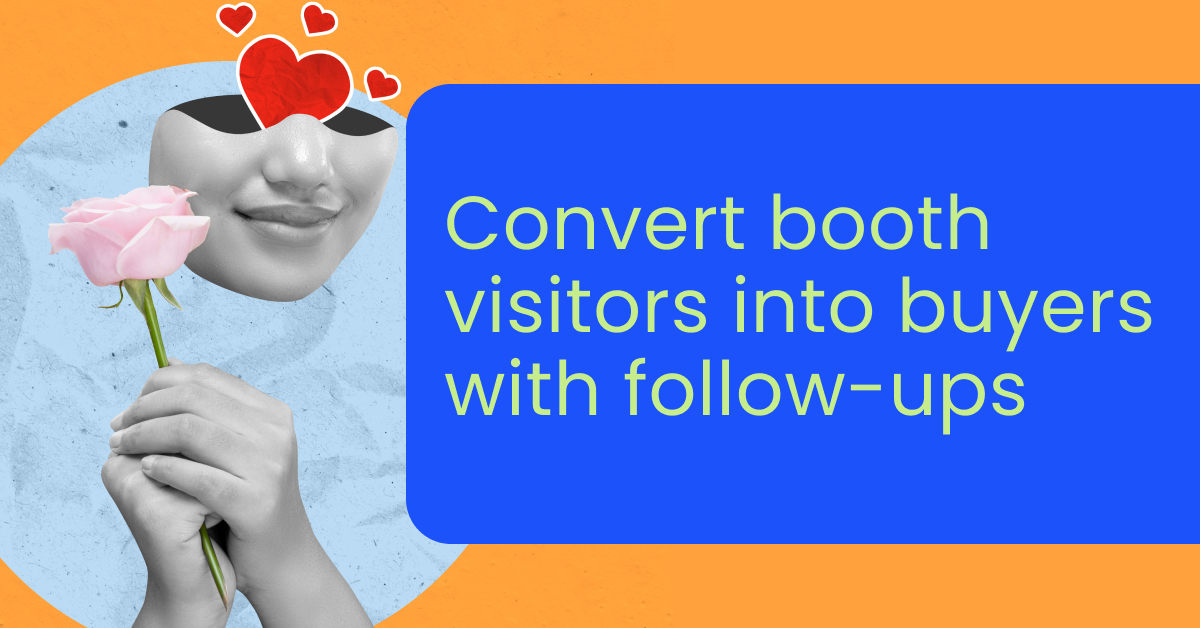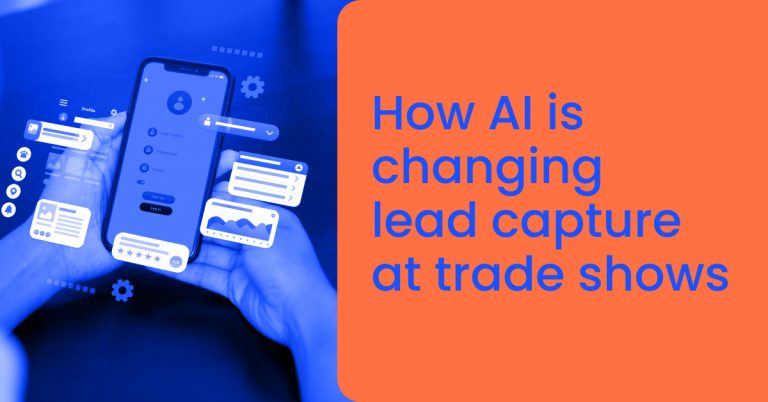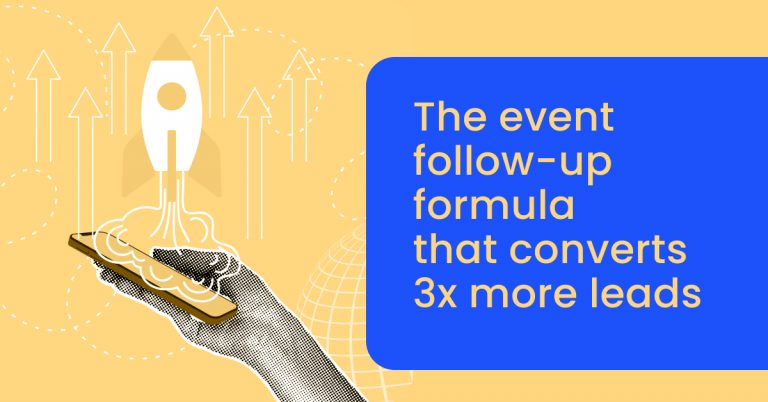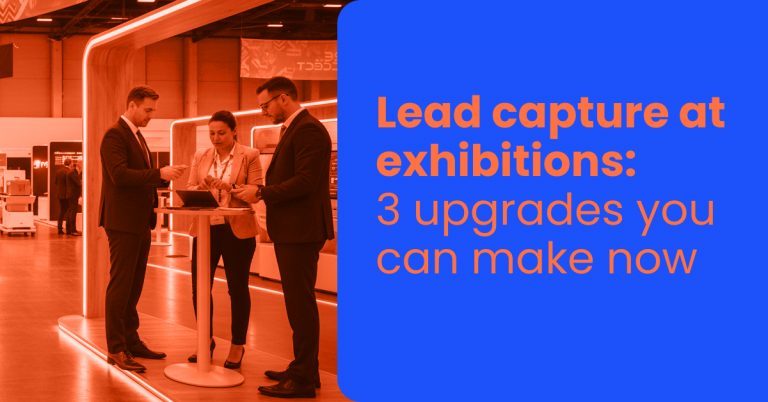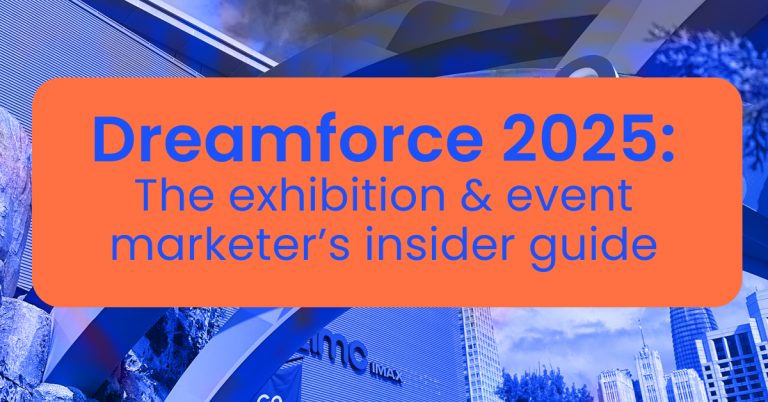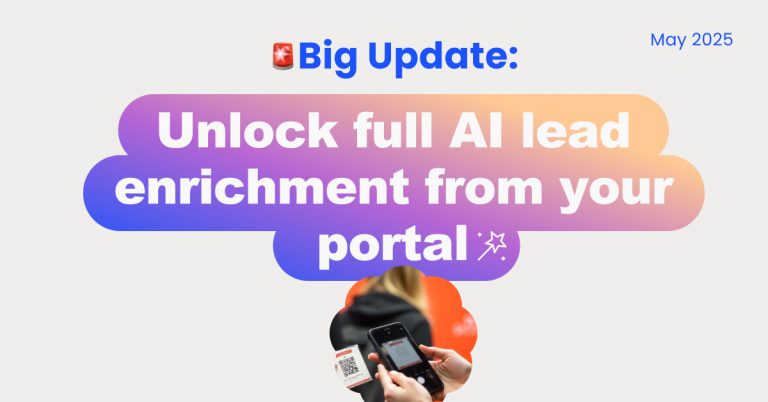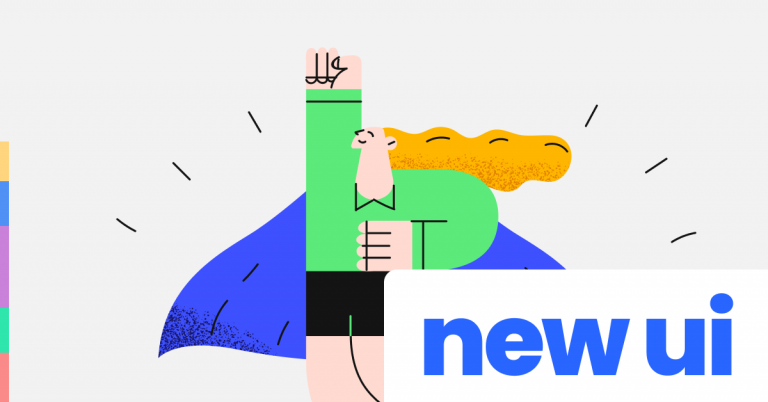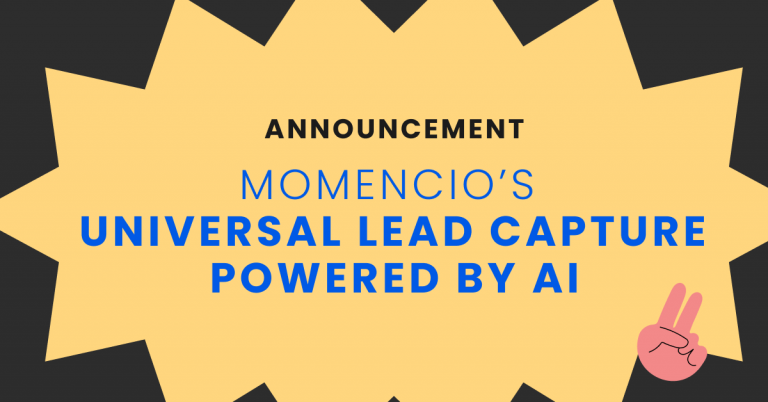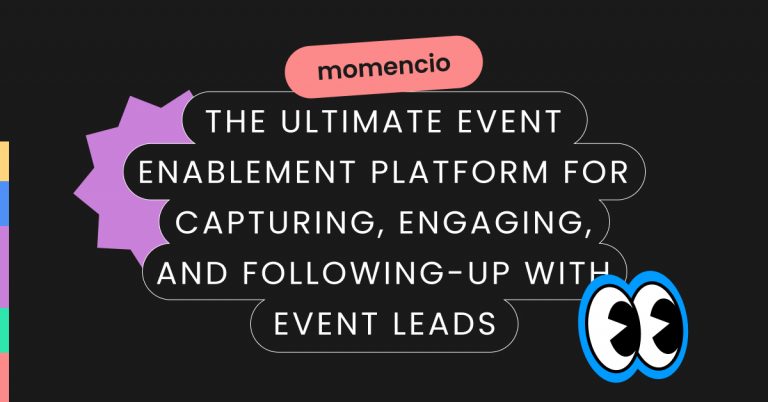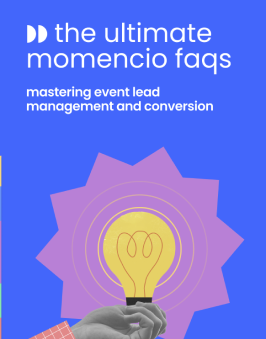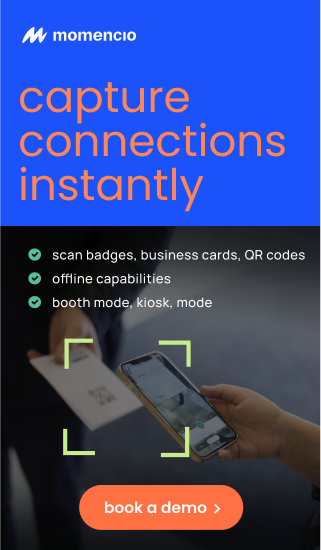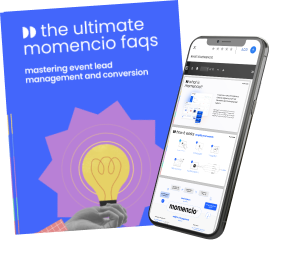Did you know that 80% of trade show leads are never followed up? Despite the substantial investments in booth setups and marketing efforts, many businesses fail to capitalize on the sales potential of their booth visitors. According to recent studies, 76% of booth attendees expect tailored communication, and those who receive it are significantly more likely to convert into paying customers.
This article is for event professionals, marketers, and sales teams looking to bridge the gap between event interaction and sales closure. By exploring data-driven strategies, multi-channel communication, and automation tools, you’ll learn how to craft follow-ups that resonate with your booth visitors.
Get ready to transform fleeting event encounters into meaningful, revenue-generating relationships.
Why booth visitors are the perfect sales opportunity
Booth visitors represent one of the most promising opportunities for lead conversion in the sales funnel. Unlike cold prospects, these individuals have already expressed interest by engaging with your brand at a trade show or event. Understanding their unique position in the buyer journey is critical to crafting effective follow-up strategies.
Booth visitors: engaged and ready to convert
Trade shows and events are tailored to attract individuals actively seeking solutions, partnerships, or innovations in their respective industries. Studies show that 81% of trade show attendees have buying authority, making them highly qualified leads. Booth visitors are not passive participants; they’ve taken the initiative to approach your booth, signaling interest in your products or services.
What booth visitors expect
- Relevant communication: A significant 76% of attendees prefer personalized post-event messages. They value follow-ups that acknowledge their specific interests or interactions at the event.
- Prompt engagement: The likelihood of converting a lead decreases by 10% with every passing day after the event. Timing is everything, and booth visitors expect to hear from you quickly.
- Value-driven content: Beyond a thank-you email, attendees want actionable insights, exclusive offers, or educational resources tailored to their needs.
Advantages of engaging booth visitors
- High intent: By attending an event and approaching your booth, visitors have shown they’re actively exploring options. This pre-qualification sets them apart from other leads.
- Immediate recency effect: Event experiences are fresh in their minds, which makes them more likely to engage with your communication promptly.
- Brand awareness: Your booth visitors have already interacted with your brand, giving you an edge over competitors when building relationships.
Why many booth visitors are missed opportunities
Despite their potential, 30-50% of event leads are never contacted, often due to:
- Disorganized follow-up processes: Failure to collect and manage lead data effectively.
- Generic communication: Sending non-personalized messages that fail to resonate with the lead’s specific needs.
- Lack of timeliness: Delayed follow-ups allow competitors to swoop in and capture the lead’s attention.
Actionable Tip
Focus on making your first communication personalized and impactful. Mention the specific products or solutions discussed during the event and offer immediate value, such as a downloadable guide or a discount code.
Leveraging attendee data to craft personalized follow-ups
Personalization is the cornerstone of successful follow-up campaigns. Booth visitors appreciate communication that reflects their unique interests and interactions during an event. To achieve this, businesses must effectively capture, analyze, and utilize attendee data to craft tailored messages that convert interest into sales.
Capturing actionable data at events
Collecting the right data during the event sets the foundation for meaningful follow-ups. Here’s how to ensure you’re capturing what matters:
- Badge scanning and CRM integration: Use badge scanners integrated with CRM systems to instantly gather attendee details, such as name, job title, and company information.
- Surveys and polls: Deploy interactive surveys or polls at your booth to gain insights into visitor preferences and pain points.
- Notes on conversations: Train your booth staff to jot down key details about each visitor’s interests, questions, and challenges. For example, “Interested in product X for scaling operations in Q1.”
- Digital content engagement: Track which brochures, videos, or demos visitors interacted with. These engagement patterns can guide your messaging.
Analyzing and segmenting data
Once the data is collected, analyze and segment it to craft personalized communication.
- Segmentation criteria:
- Industry: Tailor messaging based on the specific needs of each sector.
- Buying stage: Identify whether the visitor is an early-stage researcher or ready to make a purchase.
- Engagement level: Prioritize leads who spent more time at your booth or attended in-depth demos.
- Tools for analysis: CRM platforms with AI capabilities can automate segmentation by scoring leads based on engagement metrics like time spent, content accessed, and expressed interest.
Crafting personalized messaging
Use the insights gathered to craft highly specific follow-up messages. Here’s how:
- Subject lines that grab attention: “Hi [Name], here’s the solution we discussed at [Event Name].”
- Address specific pain points: Reference their challenges, such as “We noticed you’re exploring [industry challenge]. Our solution simplifies this process.”
- Provide relevant content: Include links to whitepapers, case studies, or product demos related to their expressed interest.
Examples of personalized emails
Scenario 1: early-stage visitor
- Subject: “Explore how [Your Product] can solve [Specific Challenge]”
- Message: “Hi [Name], it was great connecting at [Event]. We understand you’re exploring solutions for [specific need]. Here’s a guide to help you evaluate your options.”
Scenario 2: Hot lead ready to buy
- Subject: “Get started with [Your Product] today!”
- Message: “Hi [Name], thanks for visiting us at [Event]. We’re excited to help you implement [specific solution]. Here’s a proposal based on our conversation.”
Actionable tip
Automate your email campaigns to send personalized follow-ups within 24 hours of the event. Use dynamic content to adjust messages for different lead segments automatically.
Building a multi-channel follow-up strategy
Relying on a single channel for post-event follow-ups limits your ability to engage with booth visitors effectively. A multi-channel strategy increases touchpoints, diversifies communication methods, and ensures your message resonates with your audience on their preferred platforms.
Why multi-channel engagement matters
- Higher reach: Not all booth visitors respond to emails; some may prefer LinkedIn messages, while others engage better through phone calls.
- Enhanced personalization: Each channel allows for a unique approach, enabling you to tailor your message further.
- Increased recall: Repeated interactions across channels reinforce your brand’s presence and keep your solutions top of mind.
Key channels to include in your strategy
- Email marketing
- Why it works: Direct and efficient, email remains the most effective follow-up channel, with open rates for personalized emails exceeding 30%.
- Best practices: Use compelling subject lines, dynamic content, and include links to relevant resources like product demos or case studies.
- Social media engagement
- Why it works: Platforms like LinkedIn provide a professional space to continue conversations and share valuable content.
- Best practices: Send a personalized connection request with a follow-up message, such as:
“Hi [Name], it was great meeting you at [Event]. I’d love to share insights about [specific interest].”
- Phone calls
- Why it works: Speaking directly adds a personal touch and enables immediate resolution of questions.
- Best practices: Schedule calls within 48 hours of the event and reference specific details from their visit, such as: “I noticed you were interested in [Product/Service].”
- Retargeting ads
- Why it works: Retargeting ensures your brand stays visible to booth visitors who engaged with your website or content during the event.
- Best practices: Use event-specific banners or offers in your retargeting campaigns to maintain relevance.
- Direct mail
- Why it works: A tangible, personalized note or package can stand out in a digital world.
- Best practices: Send a thank-you note or small branded gift with a follow-up message that references your booth interaction.
Timing your multi-channel follow-ups
- Day 1–2 (Post-event):
- Send a thank-you email and connect on LinkedIn.
- Use retargeting ads to reinforce brand presence.
- Day 3–5:
- Follow up with a phone call for high-priority leads.
- Share a valuable resource via email, such as a whitepaper or case study.
- Week 2–3:
- Deploy targeted ads with special offers or event-related discounts.
- Use direct mail for select leads who showed high interest.
Example follow-up sequence
- Email:
Subject: “Thanks for visiting our booth at [Event]!”
Message: “It was great speaking with you about [specific product/service]. Here’s a guide to help you explore how we can address [specific challenge].” - LinkedIn:
Message: “Hi [Name], it was great meeting you at [Event]. Let’s connect to discuss how [Your Solution] aligns with your goals.” - Phone call:
Script: “Hi [Name], I wanted to follow up on our conversation at [Event]. Do you have time to discuss next steps or any questions?”
Actionable tip
Track the performance of each channel and adapt your approach based on what resonates most with your audience. A CRM system integrated with your follow-up strategy can streamline tracking and ensure consistent communication.
Automating lead scoring to prioritize hot prospects
When managing post-event leads, not all booth visitors are equally ready to buy. Some are actively seeking solutions, while others are simply exploring. Automating lead scoring helps you prioritize hot prospects, ensuring that your team focuses its efforts on leads with the highest conversion potential.
What Is lead scoring?
Lead scoring assigns a numerical value to each lead based on their likelihood to convert into a buyer. This score is determined by analyzing engagement levels, demographic fit, and behavioral data collected during the event and follow-up interactions.
Why automate lead scoring?
- Efficiency: Automated scoring systems reduce the time spent manually evaluating leads.
- Accuracy: Machine learning and AI tools can analyze vast datasets to identify high-value prospects with greater precision.
- Actionable insights: Scored leads provide actionable data, allowing sales teams to craft tailored approaches for different tiers of prospects.
Key metrics for lead scoring
- Engagement at the event:
- Time spent at your booth.
- Participation in activities like surveys, demos, or presentations.
- Interest shown in specific products or services.
- Post-event engagement:
- Email open and click-through rates.
- Responses to follow-up communications.
- Interaction with shared content, such as case studies or videos.
- Demographics and firmographics:
- Role and decision-making authority (e.g., managers vs. executives).
- Company size and industry alignment with your offerings.
- Budget indicators discussed during booth interactions.
- Behavioral triggers:
- Revisits to your website or landing pages.
- Interactions with retargeting ads.
- Scheduling a demo or requesting more information.
Tools for automated lead scoring
- CRM platforms: Integrate tools like Salesforce or HubSpot to automate lead scoring based on predefined criteria.
- AI-powered analytics: Platforms like Marketo or Pardot use AI to evaluate engagement and prioritize leads automatically.
- Event management software: Many tools, like momencio, offer built-in scoring mechanisms that incorporate both event data and post-event interactions.
Prioritizing hot prospects
Once your leads are scored, segment them into categories to streamline follow-ups:
- High-scoring leads:
- Immediate action: Schedule a call or demo.
- Personalized, in-depth proposals tailored to their needs.
- Mid-scoring leads:
- Nurture with additional resources like webinars or whitepapers.
- Send periodic emails highlighting product features or industry insights.
- Low-scoring leads:
- Add to long-term nurture campaigns with broader content.
- Revisit after a specified period or based on new interactions.
Real-world example
Scenario: A booth visitor spent 15 minutes at your booth, engaged in a product demo, and interacted with a follow-up email by clicking on a case study link.
- Score: High
- Next step: Assign the lead to a sales representative for immediate contact with a proposal or consultation offer.
Actionable tip
Set up scoring thresholds that trigger automatic workflows, such as sending a meeting request to leads scoring above 80 points or assigning low-priority leads to an email nurture sequence.
Measuring the effectiveness of your follow-up campaigns
Measuring the performance of your follow-up campaigns is crucial to refining your approach and maximizing conversions. By tracking the right metrics, you can identify what works, address weaknesses, and build a data-driven strategy to turn booth visitors into buyers.
Key metrics to track
- Response rates
- Email: Monitor open rates, click-through rates (CTR), and reply rates to understand how well your messaging resonates.
- Social media: Track connection requests, message responses, and engagement metrics like shares or likes.
- Conversion rates
- How many booth visitors moved to the next stage of your sales funnel (e.g., scheduling a demo or requesting a proposal).
- Lead engagement scores
- Average engagement score across your leads to gauge the overall effectiveness of your campaigns.
- Pipeline progression
- Measure how many leads transitioned from being prospects to qualified opportunities and eventually closed deals.
- Channel performance
- Analyze the success of individual channels (e.g., email vs. phone calls) to allocate resources effectively.
Tools for measuring effectiveness
- CRM platforms
- Use Salesforce, HubSpot, or similar tools to track lead interactions, assign scores, and monitor progression through the sales funnel.
- Analytics tools
- Google Analytics or campaign tracking software can provide insights into website traffic and lead behavior triggered by follow-up actions.
- Marketing automation platforms
- Platforms like Marketo or Pardot offer built-in analytics dashboards to measure campaign performance.
Refining your follow-up strategy based on metrics
- Analyze drop-off points
- Identify where leads disengage, such as low email CTRs or declining call response rates. Adjust messaging or timing to address these gaps.
- A/B testing
- Test different subject lines, follow-up times, or messaging styles to identify what resonates best with your audience.
- Feedback integration
- Collect feedback from leads during follow-ups to refine your approach. For instance, if multiple leads express confusion about pricing, address it in future outreach.
Benchmarks for success
- Email open rates: Aim for at least 20-30% for personalized follow-ups.
- Response rates: A strong campaign should see response rates of 10-15%.
- Conversion rates: Expect a 20-25% conversion from hot leads to the next funnel stage.
Example adjustment based on metrics
Scenario:
- Emails show a high open rate (35%) but a low CTR (10%).
- Action: Refine your email content to include a clearer call-to-action (CTA) and improve link placement for better visibility.
Actionable tip
Regularly review your metrics in monthly or quarterly intervals to adapt to evolving trends and lead behavior. Use a feedback loop to improve every stage of your follow-up strategy.
Conclusion
Effectively converting booth visitors into buyers requires a structured, data-driven follow-up strategy that combines personalization, multi-channel outreach, and automation. These efforts ensure that the connections made at events are nurtured into meaningful business relationships.
Key takeaways
- Booth visitors are high-value leads: With their immediate interest and active participation, booth visitors are primed for conversion when approached with the right strategy.
- Leverage data for personalization: Capturing actionable data during events and using it to tailor your follow-ups creates a personalized experience that resonates.
- Adopt a multi-channel strategy: Diversify your outreach to include emails, social media, phone calls, and retargeting ads for maximum engagement.
- Prioritize hot prospects with lead scoring: Automating lead scoring helps you focus on the most promising leads, ensuring efficient use of your resources.
- Measure and refine your campaigns: Continuously analyze performance metrics to optimize your strategy and improve results over time.
By implementing these strategies, businesses can maximize their ROI from trade shows and events, ensuring that no lead is left behind.
FAQs
- How soon should you follow up with booth visitors?
- Follow up within the first 24-48 hours after the event. Timely communication ensures your brand remains top of mind while the event is still fresh in the visitor’s memory.
- What tools can help personalize follow-ups?
- CRM platforms like Salesforce and HubSpot, paired with marketing automation tools such as Pardot or Marketo, enable businesses to craft personalized and automated follow-up messages.
- How do you prioritize leads effectively?
- Automated lead scoring systems assign values based on engagement and demographic fit, helping you focus on high-value leads.
- What channels work best for follow-ups?
- Email, LinkedIn, phone calls, and retargeting ads are effective channels. Use a combination to ensure broader reach and higher engagement.
- What are common mistakes to avoid in lead nurturing?
- Avoid delays in follow-ups, sending generic messages, and failing to provide clear next steps or calls to action.
